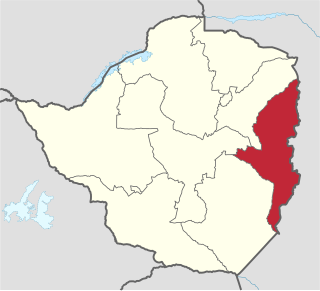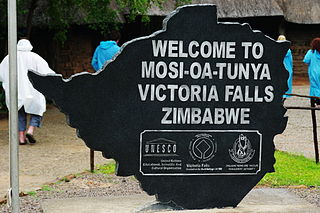
Mbira are a family of musical instruments, traditional to the Shona people of Zimbabwe. They consist of a wooden board with attached staggered metal tines, played by holding the instrument in the hands and plucking the tines with the thumbs, the right forefinger, and sometimes the left forefinger. Musicologists classify it as a lamellaphone, part of the plucked idiophone family of musical instruments. In Eastern and Southern Africa, there are many kinds of mbira, often accompanied by the hosho, a percussion instrument. It is often an important instrument played at religious ceremonies, weddings, and other social gatherings. The "Art of crafting and playing Mbira/Sansi, the finger-plucking traditional musical instrument in Malawi and Zimbabwe" was added to the UNESCO Representative List of the Intangible Cultural Heritage of Humanity in 2020.

Zimbabwean music is heavily reliant on the use of instruments such as the mbira, Ngoma drums and hosho. Their music symbolizes much more than a simple rhythm, as the folk and pop style styled music was used as a symbol of hope for Zimbabweans looking to gain independence from Rhodesia. Music has played a significant role in the history of Zimbabwe, from a vital role in the traditional Bira ceremony used to call on ancestral spirits, to protest songs during the struggle for independence. The community in Zimbabwe used music to voice their resistance to their oppression, as one of the only weapons they had available to fight back with. In the eighties, the Music of Zimbabwe was at the center of the African Music scene thanks to genres such as Sungura and Jit. However, several performers were banned by state TV and radio leading to the closing of several music venues.

Manicaland is a province in eastern Zimbabwe. After Harare Province, it is the country's second-most populous province, with a population of 2.037 million, as of the 2022 census. After Harare and Bulawayo provinces, Manicaland is Zimbabwe's third-most densely populated province. Manicaland was one of five original provinces established in Southern Rhodesia in the early colonial period. The province endowed with country's major tourist attractions, the likes of Mutarazi Falls, Nyanga National Park and Zimbabwe's top three highest peaks. The province is divided into ten administrative subdivisions of seven rural districts and three towns/councils, including the provincial capital, Mutare. The name Manicaland is derived from one of the province's largest ethnic groups, the Manyika, who originate from the area north of the Manicaland province and as well as western Mozambique, who speak a distinct language called ChiManyika in Shona.
The Manyika tribe is a Shona sub-group that originated from Manyika Dynasty. Manyika people speak several dialects which include ChiManyika, ChiBocha, ChiUngwe, ChiHera, Chijindwi and the Urban dialect which is spoken in urban centers like Mutare and Rusape.
Mukarakate is a place in the north-eastern Murewa district of Zimbabwe. The district is in Mashonaland East province of Zimbabwe. It is almost entirely inhabited by Shona-speaking people. The traditional rulers of the area are the Nhowe people, whose chieftainship is called Mangwende. Many of the Nhowe people use Mukarakate as a surname, because it is the name of a great-great-ancestor of the tribe. Their totem is 'Moyo Muzukuru', which uses the bull as its symbolic animal. However, in practice, the tribe strictly holds only the heart of the animal as sacred, not the whole animal. Currently, the Mangwende Chieftainship is vacant following the death of Jonathan Tafirenyika Chibanda who passed on in South Africa on 16 December 2013. Chief Jonathan Mangwende was once president of the chief's council. Jonathan Tafirenyika Chibanda was the son of Chief Chataika Chibanda Mangwende. Chibanda became chief Mangwende in 1926 and died in 1936. Chibanda only ruled for 10 years. Jonathan Tafirenyika Chibanda become chief Mangwende in 1968. Prior to that he was a teacher at Chinhenga primary school. It is widely believed that the next Chief Mangwende will come from the Bokoto lineage. In modern-day Zimbabwe, the surname is still widely used in the area. Mukarakate is at the border post of Mrewa south and Mutoko South

African dance refers to the various dance styles of sub-Saharan Africa. These dances are closely connected with the traditional rhythms and music traditions of the region. Music and dancing is an integral part of many traditional African societies. Songs and dances facilitate teaching and promoting social values, celebrating special events and major life milestones, performing oral history and other recitations, and spiritual experiences. African dance uses the concepts of polyrhythm and total body articulation. African dances are a collective activity performed in large groups, with significant interaction between dancers and onlookers in the majority of styles.

The Shona people are a Bantu ethnic group native to Southern Africa, primarily living in Zimbabwe where they form the majority of the population, as well as Mozambique, South Africa, and a worldwide diaspora. There are five major Shona language/dialect clusters: Manyika, Karanga, Zezuru, Korekore, and Ndau.
Svikiro is a spirit medium of the Shona people of Zimbabwe.

Nehanda Charwe Nyakasikana also known as Mbuya Nehanda was a svikiro, or spirit medium of the Zezuru Shona people. She was a medium of Nehanda, a female Shona mhondoro. As one of the spiritual leaders of the Shona, she was one of the leaders of a revolt, the Chimurenga, against the British South Africa Company's colonisation of what is now Zimbabwe led by Cecil John Rhodes in 1889. She was a Hera of the HwataShava Mufakose Dynasty. She and her ally Sekuru Kaguvi were eventually captured and executed by the company on charges of murder. She has been commemorated by Zimbabweans by statues, songs, novels, and poems, and the names of streets and hospitals. The legacy of the medium continued to be linked to the theme of resistance, particularly the guerrilla war that began in 1972. Her name became of increasing importance to the nationalist movements in Zimbabwe.
Solomon Mangwiro Mutswairo, also spelt Mutsvairo, was a Zimbabwean novelist and poet. A member of the Zezuru people of central Zimbabwe, he wrote the first novel in the Shona language, Feso.

Mberengwa, originally known as Belingwe, is a district in Midlands province in Zimbabwe. The district is now divided into sub-districts: Mberengwa North, East, West and South. It is bounded by Gwanda in Mberengwa west, and by Zvishavane in its northern zone, to the south it stretches to Neshuro, Chikombedzi and bounded by Manyuchi dam.

Dancing in Zimbabwe is an important aspect of the Zimbabwean culture, tradition, spirituality and history. There are many dances that reflect the culture of the people, although the dances may have changed throughout the years. Ethnic diversity is also a key factor in influencing the dances of the Zimbabwean culture. These dances are self-reflective, for the entire community because all music and dance are communal events. Dance to Zimbabweans is a very spiritual, powerful tool that carries on traditions, and chronicles the important events of their history and culture.

A nganga is a spiritual healer, diviner, and ritual specialist in traditional Kongo religion. These experts also exist across the African diaspora in countries where Kongo and Mbundu people were transported during the Atlantic slave trade, such as Brazil, the southern United States, Haiti and Cuba.

Many languages are spoken, or historically have been spoken, in Zimbabwe. Since the adoption of its 2013 Constitution, Zimbabwe has 16 official languages, namely Chewa, Chibarwe, English, Kalanga, Koisan, Nambya, Ndau, Ndebele, Shangani, Shona, sign language, Sotho, Tonga, Tswana, Venda, Xhosa. The country's main languages are Shona, spoken by only 42% of the population, and Ndebele, spoken by roughly 39%. English is the country's lingua franca, used in government and business and as the main medium of instruction in schools. English is the first language of most white Zimbabweans, and is the second language of a majority of black Zimbabweans. Historically, a minority of white Zimbabweans spoke Afrikaans, Greek, Italian, Polish, and Portuguese, among other languages, while Gujarati and Hindi could be found amongst the country's Indian population. Deaf Zimbabweans commonly use one of several varieties of Zimbabwean Sign Language, with some using American Sign Language. Zimbabwean language data is based on estimates, as Zimbabwe has never conducted a census that enumerated people by language.

The Kingdom of Zimbabwe was a medieval Shona kingdom located in modern-day Zimbabwe. Its capital, today's Masvingo, which is commonly called Great Zimbabwe, is the largest stone structure in precolonial Southern Africa. This kingdom came about after the collapse of the Kingdom of Mapungubwe.

Nyau is a secret society of the Chewa, an ethnic group of the Bantu peoples from Central and Southern Africa. The Nyau society consists of initiated members of the Chewa people, forming the cosmology or indigenous religion of the people. Initiations are separate for men and for women, with different knowledge learned and with different ritual roles in the society according to gender and seniority. Only initiates are considered to be mature and members of the Nyau.
Traditional African religions have faced persecution from Christians and Muslims. Adherents of these religions have been forcefully converted to Islam and Christianity, demonized and marginalized. The atrocities include killings, waging war, destroying of sacred places, and other atrocities.
Uzumba-Maramba-Pfungwe, also known as UMP, is a district of Mashonaland East Province in Zimbabwe. It consists of the northern part of the pre-1969 larger Murehwa (Mrehwa) District and includes the village of Uzumba. The area is inhabited by the Budja Shona people. The staple food crop is maize, with secondary vegetable crops.
Mangwende is a dynasty from Southern Africa, Zimbabwe commonly known as Mangwende dynasty of Nhowe or Mangwende of Nhowe. It is the royal dynasty of the Nhowe people, who are a part of the Shona tribe now living in Murewa, Mashonaland East, Zimbabwe. The Mangwende dynasty was started by the patriarch of the Nhowe people, Sakubvunza in 1606 who established the Shona traditional state of Nhowe. The name Nhowe refers to the traditional state as well as the Nhowe people.
Mhande is a traditional performance practiced among the Shona people, involving music and dance. It is a vital element of the mutoro ceremony, an annual rain ritual of the Karanga.












